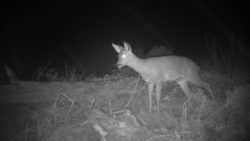Deer Impact Assessment
The interaction between deer populations and woodland regeneration is an important subject. In areas where deer population density is high, such as some parts of Scotland, their browsing habits can prevent tree saplings from establishing. With no remaining natural predation, and low levels of woodland cover in the UK, the effects of deer need to be monitored and evaluated.
We have trialled (Spring 2020) a survey methodology developed by the deer initiative to assess and monitor the impact deer and other herbivores has on regenerating trees and other fauna. As we repeat the survey each Spring we will build up a better picture of how the numbers and behaviour of deer affect the forest. A few notes on our initial findings are below.
• Red and roe deer appear to be present across the site, and use most areas relatively evenly, with only localised areas of heavy damage.
• Generally activity level appears medium, and impact is low to medium.
• However this impact seems to be dependent on the tree species, with birch and willow managing to get away but rowan, hawthorn, holly (the more palatable trees) not doing so well.
• It is therefore worth bearing in mind (in future surveys) whether the impact is affecting the diversity of tree species.


